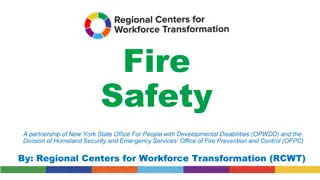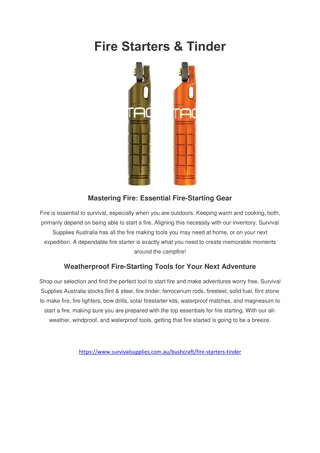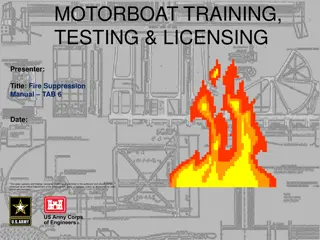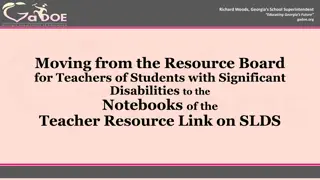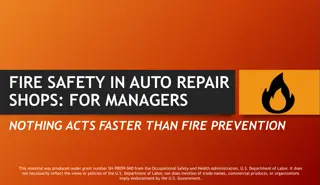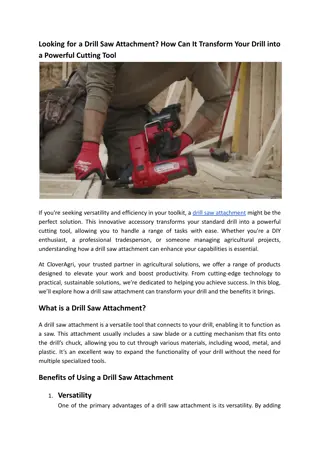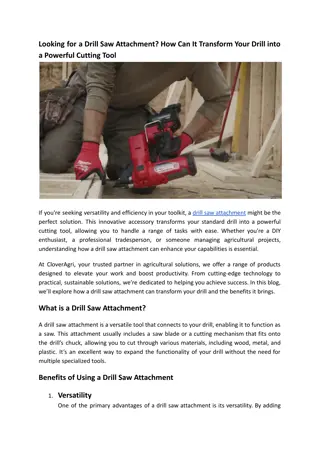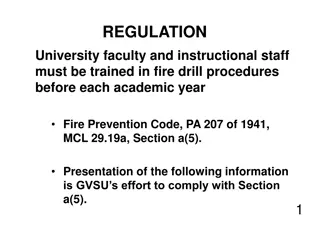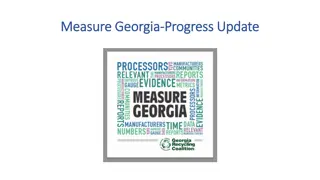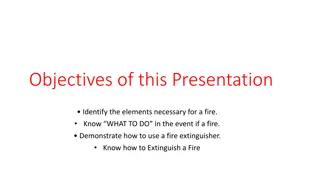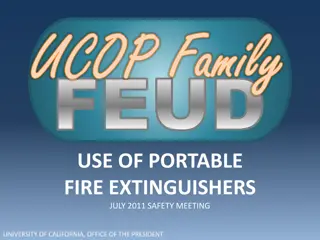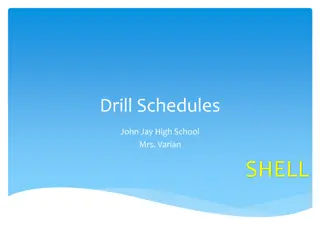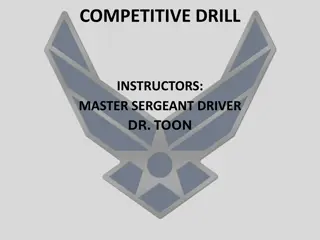School Fire Drill Requirements and Recommendations in Georgia
Georgia Safety Fire Marshal, Amanda Jones, and the State Fire Marshal's Office emphasize the importance of conducting fire drills in schools according to specific regulations. The drills must be completed within certain timeframes, reported online, and can be substituted during Severe Weather Weeks. Monthly drills are required, and involving the local Fire Department is encouraged. Unplanned drills can also be considered, and varying drill times are recommended for thorough preparedness.
Download Presentation

Please find below an Image/Link to download the presentation.
The content on the website is provided AS IS for your information and personal use only. It may not be sold, licensed, or shared on other websites without obtaining consent from the author.If you encounter any issues during the download, it is possible that the publisher has removed the file from their server.
You are allowed to download the files provided on this website for personal or commercial use, subject to the condition that they are used lawfully. All files are the property of their respective owners.
The content on the website is provided AS IS for your information and personal use only. It may not be sold, licensed, or shared on other websites without obtaining consent from the author.
E N D
Presentation Transcript
Georgia Safety Fire Marshal
Amanda Jones Lead Fire and Life Safety Educator and Reporting Supervisor Fire and Life Safety Education Fire Incident Reporting 1. Emergency Drill Reporting 2. Assisting Fire Departments and Communities across the State with Fire and Life Safety Programs. 3. We Team with agencies such as GEMA, DOE, GFSTC, and School Resource Officers.
School Emergency Drill
School Emergency Drill Code Based upon the provisions and charge of Code Section 25-2-31 of the official Code of Georgia the State Fire Marshal s Office is charged with the responsibility to carry on a statewide program of fire prevention education in the schools of this state and to establish fire drills therein. International Fire Code under Section 404.2 to require an approved Fire Safety and Evacuation Plan, shall be prepared and maintained for educational occupancies and buildings. Fire evacuation drills must be conducted monthly with all occupants participating. Reporting of all drills must be submitted electronically to the Office of the Safety Fire Commissioner.
What is required? 1.Within the first 10 days of School a Fire Drill must be completed 2.Within the first 30 days of School a Second Fire Drill must be completed. 3.A Fire Drill must be completed every month that the school is in session. 4.During the months of February and November Fire Drills can be substituted for a Severe Weather Drill or a Lockdown Drill. 5.All Drills must be reported on the online state portal. SCHOOL FIRE DRILL REPORTING
Statewide 1. Sever Weather (NOAA schedules dates) a) February b) November 2.Lockdown Drills a) TBD 3.Fire Drills a)October Fire Prevention Week
Do you want to receive a report for your entire school system? Report can be sent to you that provides a list of schools that have reported drills for you school system.
Recommendations 1. Call your local Fire Department out at least once a year to take part in your Fire Drill. 2. Report all drills in the system? 3. Unplanned drills can be used as your drill for the month. 4. Conduct the drills at different times during the day.
Do you have any questions? Thank you! Phone Number Email Address Website (470) 725-5722 ajones@oci.ga.gov www.oci.georgia.gov
Craig Landolt State Fire Marshal Hazardous Materials License under Fire Marshal Manufactured Housing Building Inspections 1.Inspection of schools 2.Review of construction plans 3.Investigate complaints 4.Consultation visits
NFPA issued a Tentative Interim Amendment (TIA) for 2018 NFPA 101 Section 15.2.2.4 for Existing Educational occupancies In response to educational occupancies using dangerous / unapproved methods for door locking. 15.2.2.2.4 Classroom Door Locking to Prevent Unwanted Entry Added a new item to allow 2 non-simultaneous releasing operations on doors. TIA 18-20 was effective August 26, 2019.
TIA 18-20 February 16, 2022, a letter was issued by State Fire Marshal Landolt recognizing TIA 18-20 as part of the 2018 LSC. The State Fire Marshal s Office does not recommend or endorse any product or devices. Each case will be reviewed on a case-by-case situation. The Chief Fire Official of the local responding fire department must approve the locking device.
2021 NFPA 101 incorporated the language of the TIA into the code 15.2.2.2.4 Existing Educational Occupancies. 17.2.2.2.6 Existing Daycare occupancies. Requirements are the same for both Existing Educational and Daycare. 120-3-3 modified to include the 2021 code language.
15.2.2.2.4.1 and 17.2.2.26.1 both allow doors to classrooms and other instructional spaces/client spaces to be locked provided that: Locking means is approved. All the following conditions are met.
(4) The releasing mechanism for unlocking and unlatching shall be located at a height not less than 34 in. (865 mm) and not exceeding 48 in. (1220 mm) above the finished floor. (5) Locks, if remotely engaged, shall be unlockable from the egress side of the door without the use of a key, tool, or special knowledge or effort. (6) The door shall be capable of being unlocked and opened from outside the room with the necessary key or other credential.
(7) The locking means shall not modify the door closer, panic hardware, or fire exit hardware or impair their operation. (8) Modifications to fire door assemblies, including door hardware, shall be in accordance with NFPA 80. (9) The emergency action plan, required by 17.7.1 / 15.7.1, shall address the use of the locking and unlocking means from both sides of the door. (10) Staff shall be drilled in the engagement and release of the locking means, from both sides of the door, as part of the emergency egress drills required by 17.7.2 / 15.7.2.
15.2.2.2.4.2 Where existing classroom doors and doors to instructional spaces are replaced, they shall comply with the provisions of 14.2.2.2.4. 17.2.2.2.6.2 Where existing classroom doors and doors to client care spaces are replaced, they shall comply with the provisions of 16.2.2.2.6.
The 2018 Edition of NFPA 101 Life Safety Code incorporated major changes in the requirements for automatic sprinkler protection in new educational occupancies. Paragraph 14.3.5.1 requires education occupancy buildings to be protected throughout by an approved, supervised automatic sprinkler system. This applies to all new schools with very few exceptions.
NFPA 101Paragraph 14.3.5.2 exempts the requirements for an automatic sprinkler system in new schools under certain conditions (1) Non-relocatable buildings having an area not exceeding 1000 ft2 (2) Non-relocatable buildings containing a single classroom (3) Relocatable buildings (portable classrooms) complying with all of the following: (a) Building area does not exceed 1000 ft2 (b) Building contains a single classroom (c) Building is located not less than 30 ft from another building
Recognizing the financial burden requiring school systems to install automatic sprinkler systems in portable classrooms for short term durations a proposed modification to paragraph 14.3.5.2 item (3) has been proposed. A hearing was held on August 5, 2022, on the proposed change The proposed change deletes the current paragraph 14.3.5.2 item (3) and replaces it with a new 14.3.5.2 item (3) The change gives more flexibility on not requiring automatic sprinklers portable classrooms
New paragraph 14.3.5.2 item (3) to omit automatic sprinkler system in portable classrooms (3) Relocatable buildings complying with all of the following: (a)Building contains a maximum of 2 classrooms. (b) Each classroom has 2 independent doors remotely located in accordance with 7.5.1.3 of this code leading directly to the outside of the building. (c) Building is located not less than 30 feet (9.1 m) from another building or other relocatable building. (d) Building has a fire alarm system connected to the main school building fire alarm.
SHIELD School Hallway Interior Emergency Lockdown Defense
Do you have any questions? Thank you! Phone Number Email Address Website (470) 270-6499 clandolt@oci.ga.gov www.oci.georgia.gov


